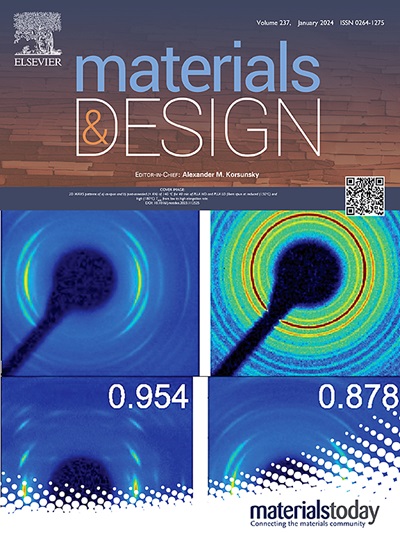注射透明质酸水凝胶通过抑制氧化应激,炎症和新生血管管理角膜
IF 7.9
2区 材料科学
Q1 MATERIALS SCIENCE, MULTIDISCIPLINARY
引用次数: 0
摘要
角膜新生血管(CNV)是全球视力障碍和失明的重要因素。尽管如此,现有的治疗方式,包括手术干预和药物治疗,面临着与有限的疗效和潜在的不良反应相关的挑战。在这项研究中,我们开发了一种靶向递送抗血管生成肽KV11的水凝胶配方,利用己二酰二肼修饰的透明质酸(AHA)、原儿茶醛(PA)和MnO2之间的多种物理化学相互作用。PA和MnO2的掺入使水凝胶具有抗氧化性能,使其能够有效清除DPPH自由基和羟基自由基。因此,水凝胶在体外对人角膜上皮细胞(HCECs)具有显著的抗氧化和抗凋亡作用,并能有效抑制M1巨噬细胞的极化。此外,水凝胶制剂能够抑制内皮细胞的迁移和增殖。负载kv11的水凝胶治疗可显著改善碱烧伤所致CNV大鼠模型的病理性角膜损伤。此外,该水凝胶材料对眼表具有安全性和无毒性。本研究设计了一种多功能透明质酸水凝胶配方,通过整合具有抗氧化性能的材料,特别是PA和MnO2,以及KV11,有效解决氧化应激、急性炎症反应和新生血管形成带来的复杂挑战,为CNV的治疗提供了一种有希望的策略。本文章由计算机程序翻译,如有差异,请以英文原文为准。

Injectable hyaluronic acid hydrogel for corneal neovascularization management by inhibiting oxidative stress, inflammation and neovascularization
Corneal neovascularization (CNV) represents a significant global contributor to vision impairment and blindness. Nonetheless, existing therapeutic modalities, including surgical interventions and pharmacological treatments, face challenges related to limited efficacy and potential adverse effects. In this study, we developed a hydrogel formulation for the targeted delivery of the anti-angiogenic peptide KV11 leveraging multiple physicochemical interactions among adipic dihydrazide-modified hyaluronic acid (AHA), protocatechuic aldehyde (PA), and MnO2. The incorporation of PA and MnO2 conferred antioxidant properties to the hydrogel, enabling it to effectively scavenge DPPH free radicals and hydroxyl radicals. Therefore, the hydrogel demonstrated notable antioxidant and anti-apoptotic effects in human corneal epithelial cells (HCECs) and effectively inhibited M1 macrophage polarization in vitro. Additionally, the hydrogel formulation was capable of suppressing the migration and proliferation of endothelial cells. Treatment with the KV11-loaded hydrogel significantly ameliorated pathological corneal injury in a rat model of alkali burn-induced CNV. Furthermore, the hydrogel material demonstrated safety and non-toxicity to the ocular surface. This study designed a multifunctional HA hydrogel formulation by integrating materials with antioxidant properties, specifically PA and MnO2, along with KV11, effectively addressing the complex challenges posed by oxidative stress, acute inflammatory responses, and neovascularization, providing a promising strategy for the treatment of CNV.
求助全文
通过发布文献求助,成功后即可免费获取论文全文。
去求助
来源期刊

Materials & Design
Engineering-Mechanical Engineering
CiteScore
14.30
自引率
7.10%
发文量
1028
审稿时长
85 days
期刊介绍:
Materials and Design is a multi-disciplinary journal that publishes original research reports, review articles, and express communications. The journal focuses on studying the structure and properties of inorganic and organic materials, advancements in synthesis, processing, characterization, and testing, the design of materials and engineering systems, and their applications in technology. It aims to bring together various aspects of materials science, engineering, physics, and chemistry.
The journal explores themes ranging from materials to design and aims to reveal the connections between natural and artificial materials, as well as experiment and modeling. Manuscripts submitted to Materials and Design should contain elements of discovery and surprise, as they often contribute new insights into the architecture and function of matter.
 求助内容:
求助内容: 应助结果提醒方式:
应助结果提醒方式:


